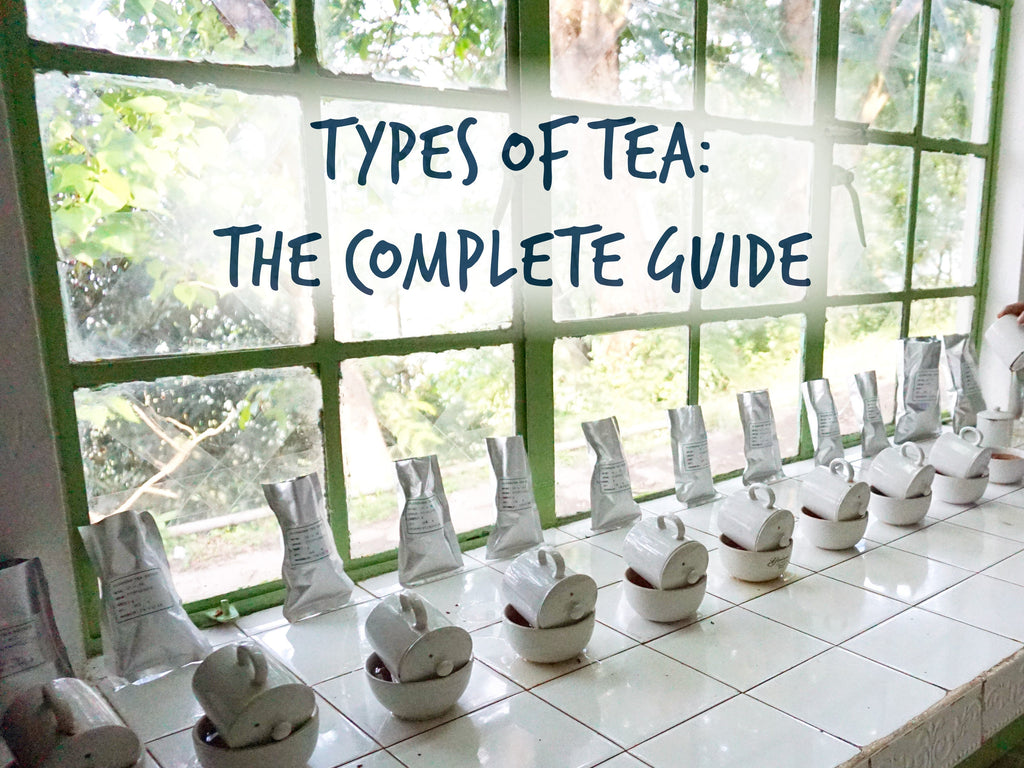
After writing our ultimate guide to loose leaf tea, we thought it would be great to delve into the different types of tea in more detail. If you want to understand your black teas from your oolongs, or your greens from your whites, this is the article for you!
We’ll take a look at the 6 main types of tea, what makes them unique, how they’re grown and produced, as well as a little bit about their taste profiles.
Hopefully we’ll help you to decide on the best tea for you, and maybe you’ll even find a new favourite…
Black tea
Your classic cup of tea! Whether it’s PG tips, Yorkshire or something way better like our own Team Breakfast loose leaf tea – black tea is a staple, especially here in the UK.
One of the big things that is often used to distinguish what category a tea falls into is oxidation. Black teas undergo a complete oxidation period during their processing, which accounts for the dark colour of the leaves. The oxidation process for tea is simply leaving the leaves out in the air to dry, darken and develop in flavour.
They can vary massively in flavour, from the most delicate Darjeeling, to the boldest Kenyan tea.
How is black tea produced?
All black tea is produced by following these steps:
- Plucked straight from the tea plant.
- Withered for upto 20 hours. The leaves are laid out in large troughs to reduce the water content.
- Rolled in a rolling machine or drum. Rolling twists the leaves, breaks down the cell walls and releases the natural juices.
- Oxidised by laying the leaves out and leaving them to rest.
- Dried to remove the moisture from the leaves and preserve them for us to brew later!

What does black tea taste like?
The flavour profile isn’t consistent across an entire category or type of tea – this applies to all types of tea, not just black teas. The environment the tea was grown in and the various steps of processing the leaf goes through will have a big impact on flavour.
So, while you may expect a black tea to be a bolder flavour, perhaps even stronger (both in taste and caffeine content), this generalisation is inaccurate. This is especially true when you’re using better quality teas, such as our whole leaf teas, rather than a big brand tea bag straight from the supermarket.
You can expect a whole range of delectable flavours with black teas, ranging from caramels to woody flavours, as well as fruits like plum and raisins.
Here’s a little taster of what to expect from our loose leaf black teas:
Peregrine Mountain 1st Flush – smooth with notes of raisin, plum and caramel.
Margaret’s Hope Darjeeling – muscat grapes that give a wine like taste, with a hint of currants.
Team Breakfast – cask oak with malty notes.
Explore all of our loose leaf black teas.
Green tea
Green tea is at the other end of the scale compared to black tea, with no oxidation. The leaves are picked and quite quickly put through a heating process. This step destroys the enzymes that cause oxidation – this results in the lighter colour, when compared to black tea.
How is green tea produced?
- Plucked straight from the tea plant.
- Heated to kill the enzymes that cause oxidation. This is either done by a dry heat, known as panning, or a wet heat, steaming.
- Rolled or pressed to develop flavour.
- Dried to remove the moisture from the leaves and preserve them for us to brew later!
What does green tea taste like?
People often associate green tea with a more delicate flavour than black tea. Of course, this all depends on growing conditions, production and how it’s brewed.
It has an unfair reputation as being a bitter drink – this is more often than not down to brewing conditions. Lower water temperatures and shorter brewing times are more favourable for creating a delicious cup of green tea.
You can expect more grassy, leafy or even vegetal flavours from green tea. Here’s some of our favourites and their tasting notes, to give you an idea:
GABA Sencha Green – spinach and seaweed notes, with a rich umami flavour. More buttery than the average sencha.
Gunpowder Green – a rich green tea flavour, with nutty notes and smoky undertones.
Genmaicha “Popcorn” Organic Green – this is a blend that includes brown rice. This mix delivers sweet grassy flavours along with a delicious nutty edge from the toasted rice.
Explore all of our loose leaf green teas.
Oolong tea
After looking at the two ends of the oxidation spectrum, with black and green, we’re now looking at almost everything in between. Oolong teas are typically partially oxidised, but the scale of oxidation is quite broad.
The less oxidised oolong teas are more like a green or white tea, with a much lighter brew and more delicate flavours. Then you have the more oxidised versions, which are not as dark as black tea, but are closer to that end of the scale, and are richer in colour.
How is oolong tea produced?
- Plucked straight from the tea plant.
- Withered, often in sunlight, then moved indoors.
- Shaken and bruised, usually in traditional bamboo drums.
- Heated to destroy the enzymes and stop oxidation. This step is where the level of oxidation is determined, carried out by skilled tea makers.
- Rolled lightly to develop flavour.
- Dried to remove the moisture from the leaves and preserve them for us to brew later!
- Roasted (optionally) to further develop flavour.

What does oolong tea taste like?
They’re often quite complex, with many different layers of flavour to the tea. Because of the variety of production methods used, the flavours can range from sweet and floral, to more fruity, with caramel notes.
Here are a few great examples of oolongs and their variety of flavours:
Tie Guan Yin (Iron Goddess of Mercy) – refreshing, sweet and floral. This is a really approachable oolong tea – we often call it “green tea for people who don’t like green tea”!
GABA Oolong – chestnuts, sour cherries and chocolate, with a slightly spicy edge.
Ruby 18 – caramel, dark honey and stone fruits.
Explore all of our loose leaf oolong teas.
White tea
With very few steps in its production, white tea undergoes spontaneous oxidation. It’s simply picked and dried in the sun, so there’s no strict, controlled oxidation process taking place.
This leads to a very pale brew, with the flavour usually being much lighter and often sweet.
White teas sometimes utilise the buds of the tea plant, rather than the mature leaves. These are sometimes called “silver needle” teas.

How is white tea produced?
- Plucked straight from the tea plant.
- Dried in the sun to remove the moisture from the leaves and preserve them for us to brew later!
What does white tea taste like?
The simple process, utilising the sun to dry the leaves, brings out the natural sugars in the leaves. This tends to produce a sweeter than average brew, with very delicate flavours. The sweetness often translates to fruity flavours, especially like stone fruits.
To give you an idea of the variety of flavours in white teas, here are some of our favourites:
Yin Zhen “Silver Needle” Organic – delicate, sweet with a slightly nutty flavour.
Tinderet Kenya White – apricot, pear and lychee.
Wild Tree Buds – Baked apple and pear, with a hint of caramelised sugar.
Explore all of our loose leaf white teas.
Yellow tea
The production process for yellow tea is very similar to that of green tea, but with one additional step: Men Huan. Men Huan involves wrapping wet leaves in cloth and heating them overnight – sometimes that process is carried out more than once.
How is yellow tea produced?
- Plucked straight from the tea plant.
- Heated to kill the enzymes that cause oxidation. This is either done by a dry heat, known as panning, or a wet heat, steaming.
- Rolled or pressed to develop flavour.
- Wrapped and heated overnight to ferment the leaves.
- Dried to remove the moisture from the leaves and preserve them for us to brew later!

What does yellow tea taste like?
The additional step of wrapping and heating the wet leaves creates a unique flavour. While you may expect a delicate, grassy flavour, like with green tea. Men Huan ends up creating subtle spiciness, hints of ripe mango and even a touch of roast dinner!
Yellow teas are becoming increasingly rare, but we have a great tea that displays the unique flavours of the yellow variety:
Kekecha Yellow – gentle spiciness with a hint of buttery roast dinner.
Explore all of our loose leaf yellow teas.
Dark tea
The most famous type of dark tea, puerh, starts life as a green tea but then undergoes a long period of fermentation. This process can take anywhere from a few weeks to a few years, depending on the tea producer and what flavour they’re looking to achieve.
The length of time it takes to make a dark tea makes them quite rare and often expensive. The process creates some truly unique and complex flavours.
How is dark tea produced?
- Plucked straight from the tea plant.
- Heated to kill the enzymes that cause oxidation. This is either done by a dry heat, known as panning, or a wet heat, steaming.
- Rolled or pressed to develop flavour.
- Fermented using one of two methods:
- Sheng (raw) puerhs are dried after rolling. After drying the leaves are steamed to add moisture, pressed into beengs (cakes) and stored in a temperature and humidity controlled environment. This allows a slow fermentation process for a number of weeks, months of even years.
- Shu (ripened) puerhs also begins with drying. It is then sprayed with water, heaped and covered. The wet, heaped tea generates heat and speeds up the fermentation process. The fermented tea is then pressed into beengs and air dried after a few weeks or months. The beengs are then stored in a temperature and humidity controlled environment for fermentation to continue at a slower rate, but for much less time than a sheng puerh.
- Dried to remove the moisture from the leaves and preserve them for us to brew later!

What does dark tea taste like?
The fermentation process really softens and deepens the flavour of dark tea. The most common description of the flavour is earthy, but there can be hints of aged rioja, smokey flavours and some people even describe them as having the smell of wet mushrooms!
We’re lucky enough to be able to offer a couple of great puerh teas that show off their complex flavours:
Shu Puerh – Earthy, smooth and mellow.
Queen of Puerh (vintage) – Earthy, with hints of spice and menthol.
Explore all of our loose leaf dark teas.
So, what’s your tipple? We hope this rundown of the different types of tea has been useful. With such a variety of amazing loose leaf teas from all over the world, we’d love to inspire people to leave their comfort zone and try something a little different.
If you enjoyed this article, please bookmark it for later, save on Pinterest or share on Facebook and Twitter!
